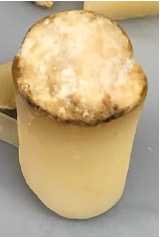Harvesting and stocking cheese rind community samples
Emily C.P. Weiss
cheese
microbiome
microbial community
harvest
store
storage
microbes
phage
bacteriophage
DNA
genomic DNA
genome
RNA
metagenomics
metatranscriptomics
scrape
rind
paste
stock
prep
preparation
prepare
spatial imaging
isolation
isolating
Abstract
This protocol describes how to harvest and stock cheese rind microbial community samples for a variety of purposes, including spatial imaging, metagenomics, metatranscriptomics, microbial isolation/culturing, and bacteriophage extraction. Processing one small cheese wheel for all of these purposes took about 45 minutes in our hands.
Steps
Equipment setup
Cool a centrifuge that can hold 1.5 mL tubes to 4 °C.
Have liquid nitrogen or a dry ice–ethanol bath ready for snap freezing samples.
Sampling for spatial imaging
Using a cheese lyre, knife, or other suitable cutting instrument, cut off a corner or other small section of the cheese to reveal a clean profile view of the cheese rind biofilm and cheese paste.

Store the cheese sections at −80 °C for later imaging.
Rind scraping
Holding the cheese in one (gloved) hand and a sterile razor blade in the other, gently scrape the surface of the cheese to remove the rind biofilm. Avoid applying too much pressure, as you will start to dig into the paste. Scrape the rind biofilm into a weigh boat or other container to clean off the blade as needed.
After removing the desired amount of rind, use a sterile wooden dowel or a pipette tip to homogenize the harvested rind.
Sampling for metatranscriptomics
Add ~200 mg of rind mixture to 1 mL of RNAprotect.
Thoroughly resuspend the rind in the RNAprotect.
Centrifuge at 4 °C for two minutes at 8000 rpm to pellet cells.
Discard the supernatant and snap freeze the sample in liquid nitrogen or a dry ice–ethanol bath.
Store the frozen cell pellets at −80 °C until RNA extraction.
Preparing glycerol stocks of full community
Prepare a solution of 1× phosphate-buffered saline with 20% glycerol. Filter sterilize with a 0.22 μm filter.
Add 2 mL of 1× phosphate-buffered saline with 20% glycerol to a 2 mL cryotube.
Add ~200 mg of rind into the 2 mL cryotube containing 2 mL of 1× phosphate-buffered saline with 20% glycerol.
Use a sterile wooden dowel to help break up the rind, which may be sticky, into smaller pieces.
Vortex for at least 20 s to homogenize the mixture.
To three new labeled empty cryotubes, distribute 500 μL of the mixture to create a total of four 500 μL glycerol stocks.
Store the glycerol stocks at −80 °C. These can be used later for microbial isolation.
Phage and other miscellaneous sample storage
If sampling the viral population, add ~200 mg of rind (or more) to a 50 mL conical tube and store at 4 °C until phage extraction.
Split the remainder of the harvested rind into 1.5 mL tubes and store at −80 °C for metagenomic DNA extraction and any other desired analyses.


